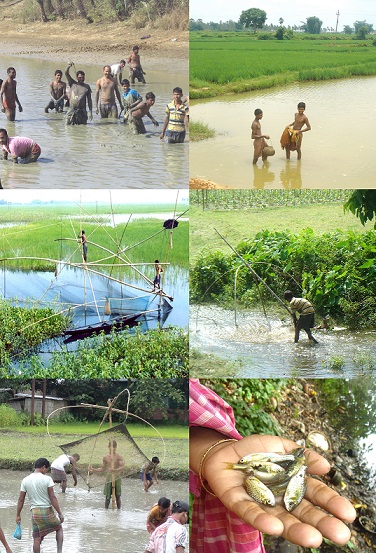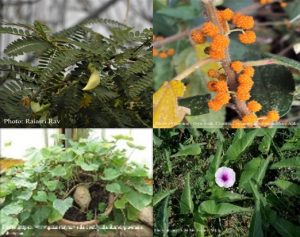One Fish, Two Fish, Red Fish, Blue Fish………..big fish big fish…..but no small fish! Yes, a key portion of small fish has already eluded our plate, so from their wild habitat. Thanks to organized fresh

water aquaculture that homogeneously produced big fish only objectively eradicating small native fish species that once were abound in various water bodies of eastern India. A bit of data check from the report of National Bureau of Fish Genetic Resources (NBFGR), Lucknow indicated that out of 2246 fish species in India 765 are from our freshwater ecosystem. Of which, around four hundred fifty small edible fishes (which grow up to 25-30 cm at adult stage of lifecycle) are distributed throughout the country in about 2.4 million hectares of ponds and tanks and 1.3 million hectares of beels, jheels and other wetlands, in addition to 0.1 million km of irrigation canals and 2.0 million hectares of reservoirs and deep water paddy field ecosystem (Gopakumar 2003). These small fishes including minor carps, catfishes, perch, murrels, eels, featherbacks, cichlids are our potential renewable bio-resource. These were abundantly available in eastern India even a decade ago in our rural ponds, low-lying paddy field environs, and similar wetland areas mostly with the onset of south-west monsoon till the end November every year. Most families in rural Bengal in particular loved to depend on such species as source of household nourishment and for livelihood support including aquarium fish trade (Figure 1) (Morales et al. 2002).
Declining trend of natural population and concerns: The scenario started changing from 1980s with the introduction of modified aquaculture practices consisting of three major carp species rohu (Labeo rohita), catla (Catla catla), mrigal (Cirrhinus mrigala) and three exotic species

silver carp (Hypophthalmichthys molitrix), grass carp (Ctenopharyngodon idellus) and the common carp (Cyprinus carpio) together called composite carp culture system. The first task of the introduction of such a new culture system was to methodically eliminate these naturally occurring small ones as ‘trash’ or ‘weed’ fishes with application of mohua oil cake (though this acts as a poison initially and kill the unwanted fishes (but becomes a manure at the end to promote growth of planktonic organisms) to reduce competition for food, dissolved oxygen and space (in the lentic-type of our freshwater ecosystem) between large carp and these small local fish varieties (Figure 2) (personal observation). Extensive and continuous efforts are being channelized even today following the same principle of growing large fishes at the cost of small fishes. It is also accompanied by the development of intensive fish culture technology to augment large fish production beyond the natural carrying capacity of the water bodies. Other factors include, exogenous application of supplementary feed (ideally, it should complement the contribution by the available natural edible organisms in water and contingent on deficiency in meeting the fish’s nutrient needs), water exchange, provision of aeration supply, use of chemical fertilizer and adoption of prophylactic measures (deliberate occasional introduction of pesticides like malathion, an organophosphorus insecticide, scheduled drugs and antibiotics to control parasitic and other diseases). These are performed in tandem to the development of multiple reproduction technique, and growth enhancement of carp species through selective breeding and marker assisted selection. In doing all these, dissemination of potential benefits to society at large and formulating conservation and management strategies for propagation of these diverse small freshwater fish species are compromised miserably and thus remain unrecognized in aquaculture activity. This is despite the fact that these small fishes are capable of contributing towards varietal diversity on daily food plate mainly for those living in urban or suburban areas and in rural region providing them with formidable amount of very high nutritional value. This offers larger benefits in terms of nutritional security by enhancing micronutrient availability which is vital for healthy growth of children especially when ‘hidden hunger’ lurking on global population.
Thus, reduction in biodiversity of many small freshwater fishes is a matter of great concern. While primary driver of this decline is large fish production for commercial gain there are other actors too, e.g., habitat shrinking resulting from anthropogenic stress, wetland area reduction due to encroachment, surface run off contamination from pest control measures in agricultural fields sprayed with agrochemicals, pollution related effects on their reproductive performances due to mixing of discharged industrial and sewage effluents.
Certain selected small fishes of West Bengal and their nutritional benefits:
A few example of some local species from West Bengal showing their risk status are: singhi (Heteropneustes fossilis), magur (Clarias batrachus), khoira (Gadusia chapra),

mourala (Amblypharyngodon mola), chang (Channa gachua), bacha (Eutropiichthys vacha), bele (Glossogobius giures), reba (Cirrhinus reba), nados (Nandus nandus), kholse (Colisa lalia), pakal (Pancallus pancallus), baspata (Ailia coila), saral punti (Puntius sarana) and several others (Figure 3). These fishes are self-recruiting in nature and their biodiversity decline are likely to make the aquatic ecosystem more vulnerable to natural disturbances including eutrophication (Mukhopadhyay 2019); moreover, they contribute to greater variety for the farmer, by increasing the physical and economic access to food of very high biological value.
Small endemic freshwater fishes as stated above including medium and minor carps like bata, punti, maurala, colisa, etc., catfishes like magur, singhi, pabda, tangra, murrels, perch, eels, folui and several others are well known sources for vital macro and micronutrients of immense importance in human nutrition and well-being, e.g., the minor carp Labeo bata (bata) is rich in long chain n-3 PUFA containing EPA (20:5n-3) & DHA (22:6n-3) (Mukhopadhyay 2009) which have multiple health benefits like preventing arterial damage, altered immunity and degeneration leading to heart attack and cerebral stroke, painful joints to name a few. Vitamin-A, cyano cobalamine, calcium, phosphorus, zinc, iodine, potassium (accompanied by low sodium) are not adequately available in common foodstuff and certain cultured fishes generally. Cereal-based diets deficient in micronutrients are relatively high among rural children and youth where intake of small fish has a large role to play.
The amount of bio-available iron, zinc, selenium for example is dependent on the content and source in the diet as well as on their absorption during food digestion. Their absorption from the plant derived food stuff is generally very low. One of the reasons is the presence of high concentration of endogenous anti-nutritional factors like phytate. Phytate occurs naturally throughout the plant kingdom and is present in considerable quantities. About 70% of the total phosphorus within cereal grains are in the form of phytate which is largely unavailable due to the absence of the enzyme phytase in our digestive tract; phytates act as strong chelator forming protein and mineral – phytate complexes with the net result being reduced protein and mineral availability (Mukhopadhyay 2012). Likewise, cereal grains are low in the concentration of carotenoid (a precursor of vitamin A), the bio-availability of vitamin A also varies with source of carotenoid in the diets.
Restoration of certain declining fish species through development of controlled culture system:
Presently, however, concerns have arisen with regard to conservation of some of these small fishes which are on the wane and it is nice that certain NGOs, progressive fish farmers or entrepreneurs

in West Bengal have come forward and putting their efforts to rear these fishes in sanctuary ponds named as ‘Abhoy Pukur’ – some kind of live gene bank at some selected locations. There are remarkable efforts at grass-root level to promote conservation and utilization of small fish in northern Bengal around Hemtabad near Raiganj of Uttar Dinajpur, near Tapan of Dakshin Dinajpur, in southern part of Bengal including Bankura, Purba Medinipur, North and South 24 Parganas. Organized captive breeding and culture of some species have been undertaken by the Department of Panchayet and Rural development and the Directorate of Fisheries, Govt. of West Bengal. Their observation is interesting in this regard, they note farming of small indigenous fish species (SIFS) like A. mola, C. batrachus, H. fossilis, A. testudineus along with major carps (L. rohita, Cirrhinus mrigala and Catla catla) and medium carps (L. bata and Cirrhinus reba) can be safely done. The economic benefits of this culture is enormous to get an additional crop that enhances the total revenue generated from this ecological niche.
With these conservation efforts, a group of village artisans who used to craft various kind of indigenous fish traps mostly made of bamboo with the of net mending (Figure 4) can continue earning their livelihood for the benefit of conservation based aquaculture and small fisheries management. It is important therefore that available water bodies under all panchayets or talukas to be utilized for production of small aquatic organic food sources. Moving further, social aquaculture on the line of social forestry may be introduced utilizing the small indigenous fish species. This may serve the dual purpose of conservation of these species as well as production of affordable animal protein for improved human health and assuring better demographic dividend for healthy rural children in a sustainable manner.
References
- Gopakumar, K (2003) Indian Aquaculture. In Sustainable Aquaculture Global perspective (Eds Jana B. B. and Webster C.D. Food Products Press, An imprint of The Haworth Press Inc. New York, London, Oxford. pp 1-10.
- Morales E.J, Little, D.C and Demaine, H 2002. Proceedings of BAU- ENRECA/DANIDA Workshop on Potentials of Small Indigenous Species of Fish (SIS) in Aquaculture & Rice-field Stocking for Improved Food & Nutrition Security in Bangladesh, 30-31 October 2002, BAU, Mymensingh, Bangladesh.(EDS Wahab, M. A, Thilsted, S H and Aoq M E. Pp 117-133.
- Mukhopadhyay P (2019) Aquatic Bioresources for Sustaining Future Food Security and Rural Livelihood support in Changing Environment. Agriculture World (5) : 76-83
- Mukhopadhyay P (2009) Fish as Nutritional Source of long chain Fatty acids. Science & Culture 75 (1-2) 53-60
- Mukhopadhyay P (2012) Precision Feeding for Sustained Freshwater Aquaculture Growth and Product Quality. Proceeding of 8th Biennial ANA Conference, 28-30 November 2012. (EDS Pattanaik AK, Varma AK, Dutta N, Sharma T and Kamra DN) pp- 151-160.
About Author:

Pratap Mukhopadhyay
The Neotia University, West Bengal, India
e-mail: pratap_in2001@yahoo.co.uk



